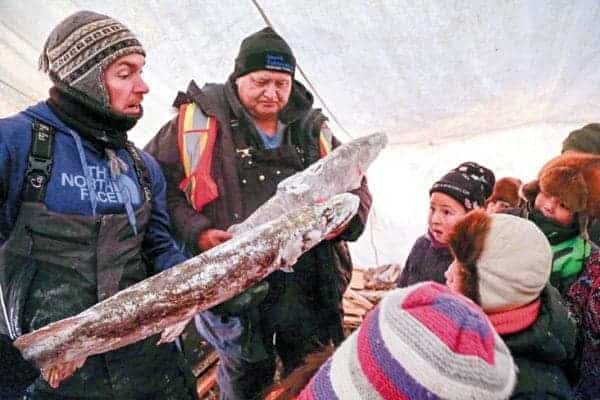Schools across the NWT are offering different Indigenous language and culture courses as the Government of the NWT (GNWT) enters year five of a 10-year education renewal plan. "A lot of what is happening through a teacher or a principal or a student's perspective in the NWT, is anyone that may experience these initiatives may have a sense that this is part of an overall renewal of education," said John Stewart, director of Teacher and Learning, a initiative run through the Department of Education Culture and Employment (ECE).

East Three Secondary School vice-principal Matthew Miller, left, and Gerry Kisoun teach students about the differences between fish in the Mackenzie River.
NNSL file photo
The renewal that Stewart speaks of started back in 2013 when then minister of ECE, Jackson Lafferty, began an initiative to get elders into every school in the NWT. Today that goal has been achieved, according to ECE, with elders being involved in different capacities at every school across the territory.
"It is indicated that all schools must have an elder in their school. Depending
on the capacity of the school and where they are, it will depend on how the elder comes in," said Jessica Schmidt, assistant director, Indigenous Languages and Education Secretariat.
The department stated that one school, K'alemi Dene in Ndilo, currently has an elder as a full-time staff member. Other schools across the territory have elders involved in a number of capacities from teaching classes, to helping with language and on-the-land programs, which ECE says have been enhanced in the last number of years.
"(On the land programs) are varied across the North depending on the capacity and location of the school," Schmidt said.
Schmidt explained that certain schools will take students on day trips out of the classroom, while others will have overnight camps out on the land. These programs are now accompanied by Indigenous language classes throughout the NWT.
"There is a new Indigenous language curriculum that has been piloted this year in partnership with language folks from around the territory and it is being expanded to all schools next year," said Stewart.
The majority of language programs in the territory follow a similar model to core French with Elizabeth Mackenzie Elementary School in Behchoko adopting a full immersion Tlicho language program. In the Dehcho students are now offered Indigenous language courses from junior kindergarten to Grade 12, he said.
"It varies from school to school because the student population varies," said Teresa Jeffrey, Superintendent, Dehcho Divisional Education Council. "We have three different high schools, so students have the option to take Slavey in Grade 10, 11 and 12 but it's also a locally designed program, not like math and English, where it was designed by ECE."
Those classes are taught using what Jeffrey calls a spiral learning system in which younger students begin to learn by using simple phrases such as asking to use the washroom or to sharpen their pencil, then once they have a solid base they become more immersed in the language. Jeffrey said that a number of students at the high school level have gone on to hold meetings with land and resources boards and meetings with members involved with treaty negotiations in traditional languages.
With the new language curriculum that has been developed with ECE, schools will be able to expand the resources that they can put towards teaching Indigenous languages, he said.
"The new curriculum acknowledges that there needs to be follow-up until people feel comfortable speaking on their own. New curriculum makes sure teachers can come together to discuss what is working and what is not," said Jeffrey.